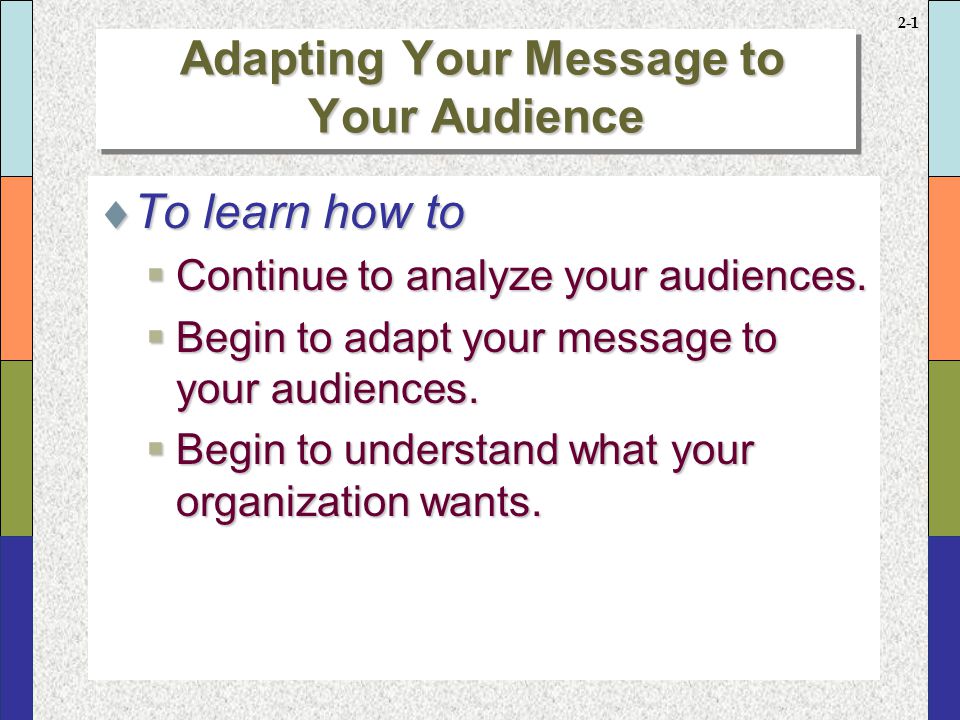How to Adapt to the Audience?
To adapt to the audience, consider their needs, interests, and preferences, and tailor your message accordingly. By understanding your audience, you can create content that resonates and engages with them effectively.
This will lead to better communication, enhanced engagement, and increased success in reaching your goals. We will explore effective strategies for adapting to your audience and how they can positively impact your communication efforts. Whether you’re delivering a presentation, writing a blog post, or creating an advertisement, adapting to your audience is key to delivering a message that truly resonates.
Understanding your audience allows you to craft content that speaks directly to their needs, interests, and preferences, creating a powerful connection. So let’s dive into the strategies that can help you successfully adapt to your audience and optimize your communication efforts.

Credit: slideplayer.com
Analyzing Your Audience
Understanding your audience is a crucial element of effective content creation and marketing strategy. By delving deep into the demographics and psychographics of your target audience, you can tailor your content to resonate with them on a personal level. This article will guide you through the process of analyzing your audience, helping you adapt your message to meet their specific needs and preferences.
Demographics
The first step in analyzing your audience is to examine their demographics. Demographics include characteristics such as age, gender, location, education level, and occupation. Understanding the demographic makeup of your audience allows you to create content that is relevant and relatable to their specific situation.
To gather information about your audience’s demographics, you can use a combination of tools such as Google Analytics, social media insights, and customer surveys. By analyzing this data, you can identify patterns and trends that will help you create content tailored specifically to your audience’s needs.
Psychographics
In addition to demographics, psychographics plays a crucial role in understanding your audience. Psychographics go beyond basic demographic information and delve into your audience’s interests, values, beliefs, and lifestyles. Understanding the psychographics of your audience allows you to create content that aligns with their interests and engages them on a deeper level.
To gather psychographic information about your audience, consider conducting online surveys or interviewing your existing customers. Ask questions that will help you understand their motivations, interests, and preferences. This data will provide valuable insights into what drives your audience and enable you to tailor your content accordingly.
When analyzing your audience’s psychographics, consider factors such as their hobbies, preferred social media platforms, consumption habits, and the type of content they resonate with. Use this information to create content that speaks directly to their interests, desires, and aspirations.
Adapting Your Content
Once you have collected and analyzed both the demographic and psychographic data of your audience, it’s time to adapt your content to resonate with them. Consider the following strategies:
- Create personas based on your audience’s demographic and psychographic data. Use these personas as a reference when creating content to ensure it aligns with their needs and preferences.
- Use language and tone that is relatable to your audience. Consider their education level and cultural background when crafting your message.
- Incorporate topics and themes that align with your audience’s interests and values. This will help build a connection and establish your content as relevant and valuable to them.
- Use visuals such as images, infographics, and videos that appeal to your audience’s aesthetic preferences.
- Optimize your content for different platforms and devices to ensure easy accessibility for your audience.
By adapting your content to the unique characteristics of your audience, you can create a more impactful and engaging experience that will resonate with them and drive desired actions.
Tailoring Your Message
Welcome to the world of content creation, where adapting to your audience is crucial for success. When it comes to reaching your target audience effectively, one size certainly does not fit all. This is why tailoring your message to resonate with your audience is essential. To achieve this, there are two key aspects to focus on: Language and Tone, as well as Relevance and Context.
Language And Tone
When creating content, the choice of language and tone can greatly impact how your message is received. Understanding your audience’s preferences, attitudes, and cultural background can help guide you in selecting the appropriate language and tone for your content.
Consider the following:
- Voice: Use an active and conversational voice to engage your audience.
- Tone: Adapt your tone depending on the subject matter and your audience’s expectations. Use a friendly and approachable tone for a casual audience, while maintaining a professional tone for a business-oriented audience.
- Vocabulary: Choose words that your audience can easily understand. Avoid jargon or technical terms unless your audience is familiar with them.
Relevance And Context
Another crucial element of tailoring your message is ensuring that your content is relevant and contextual to your audience. Here are some tips to achieve this:
- Research: Conduct thorough research on your target audience to understand their demographics, interests, and needs. This will help you create content that directly addresses their pain points and offers solutions.
- Use examples: Incorporate specific examples or stories that are relatable to your audience. This helps to make your content more relatable and engaging.
- Put yourself in their shoes: Empathize with your audience and try to understand their perspective. What challenges do they face? What are their goals and aspirations? Tailor your content to resonate with their emotions and desires.
By focusing on language and tone, as well as relevance and context, you can adapt your message to captivate your audience. Remember, successful content is not just about what you say, but also how you say it and how it relates to your audience’s needs. So, start by getting to know your audience, and let your tailored message do the rest of the work!
Using Visual Aids
When it comes to adapting to your audience, using visual aids is an effective way to enhance engagement and understanding. Visuals such as charts and graphs, images, and videos can capture attention, present information in a clear and organized manner, and make your content more engaging. Let’s explore how you can utilize these visual aids to connect with your audience.
Charts And Graphs
Charts and graphs are powerful tools that allow you to present complex data and information in a simplified and visually appealing format. By using visual elements such as colors, shapes, and lines, you can convey patterns, trends, and comparisons with ease. Here’s how to effectively incorporate charts and graphs into your content:
- Choose the right type of chart or graph based on the data you want to present. For example, use line charts to demonstrate trends over time, bar graphs to compare different categories, and pie charts to show proportions.
- Keep the design clean and uncluttered, focusing on the key data points. Avoid excessive labels or unnecessary details that may confuse your audience.
- Use colors and visuals to highlight important information or key takeaways. This will make it easier for your audience to quickly grasp the main ideas.
- Provide a brief explanation or caption for each chart or graph, summarizing the main findings or insights. Remember to use simple and concise language.
Images And Videos
Incorporating relevant images and videos into your content can add visual interest and enhance the overall user experience. These visual aids can help illustrate concepts, clarify complex ideas, and evoke emotions within your audience. Here are some tips for using images and videos effectively:
- Choose images and videos that directly relate to your content and reinforce your message. A picture or video should be worth a thousand words and contribute to the overall understanding of your topic.
- Optimize the file size and format of your visuals to ensure quick loading times and a smooth browsing experience for your audience.
- Include alt text for your images, providing a concise and descriptive explanation of what the image portrays. Alt text is essential for accessibility purposes and search engine optimization.
- Embed videos directly into your content to make it more engaging. Ensure the video is of high quality, provides subtitles or captions, and aligns with the theme and tone of your article.
By utilizing charts and graphs, images, and videos, you can effectively adapt to your audience’s preferences and deliver information in a way that is visually stimulating and easy to comprehend. Remember to keep your visuals relevant, concise, and visually appealing. Happy visual content creation!

Credit: speakerhub.com
Adapting Your Delivery
Adapting your delivery is an essential component of effective communication, especially when it comes to engaging with your audience. Whether you’re giving a presentation, writing an article, or delivering a speech, understanding the needs and preferences of your audience is crucial. One key aspect of adapting to your audience is engaging them in a way that resonates with their interests and motivations.
Engaging The Audience
Engaging your audience is crucial to capturing and maintaining their attention throughout your communication. To effectively engage your audience, consider the following strategies:
- Start with a captivating introduction to grab the reader’s attention from the beginning.
- Use compelling stories or real-life examples that relate to the topic at hand.
- Ask thought-provoking questions to encourage audience participation and stimulate their thinking.
- Include visuals such as relevant images, charts, or graphs to enhance understanding and retention.
- Inject humor when appropriate to create a more relaxed and enjoyable atmosphere.
- Emphasize the benefits and relevance of the information you are sharing to show how it can positively impact the audience.
Adapting To Learning Styles
Another crucial aspect of adapting to your audience lies in considering their learning styles. People have different ways of processing and retaining information, and tailoring your delivery to accommodate these preferences can significantly improve comprehension and engagement. The four common learning styles are:
| Learning Style | Characteristics | Effective Strategies |
|---|---|---|
| Visual Learners | Prefer visual aids, charts, and diagrams | Incorporate visual elements, use color coding, and provide handouts or slides with key points and visuals. |
| Auditory Learners | Learn best through listening and verbal explanations | Include clear and concise verbal explanations, use storytelling, and provide audio or video recordings. |
| Read/Write Learners | Prefer text-based formats, reading, and note-taking | Provide written materials, handouts, and allow time for note-taking and reflection. |
| Kinesthetic Learners | Learn by doing and through physical experiences | Incorporate hands-on activities, demonstrations, and interactive exercises. |
By considering the different learning styles of your audience, you can adapt your delivery to accommodate their preferences and enhance their understanding and engagement.
Evaluating Audience Feedback
Adapting to the audience is crucial when evaluating audience feedback. By understanding their needs and preferences, you can tailor your content to effectively engage and resonate with them.
Evaluating Audience Feedback To effectively adapt to your audience, it is crucial to evaluate and analyze the feedback you receive from them. This valuable insight allows you to gauge their preferences, needs, and expectations, enabling you to tailor your content to better suit them. In this section, we will explore two key aspects of evaluating audience feedback: active listening and feedback analysis. Active Listening Active listening is the foundation of understanding your audience. By engaging in active listening, you communicate to your audience that you value their opinions and perspectives. This involves making a conscious effort to fully concentrate on what your audience is saying and showing a genuine interest in their feedback. To effectively practice active listening, consider these techniques: 1. Maintain eye contact and use nods or other non-verbal cues to show you are attentive. 2. Avoid interrupting and allow your audience to express their thoughts fully. 3. Take notes to capture key points and ensure you don’t miss any important details. 4. ask clarifying questions to gain a deeper understanding of your audience’s perspective. 5. Reflect back on what your audience has said to confirm your understanding and show that you are actively processing their feedback. Feedback Analysis Once you have gathered feedback from your audience, the next step is to analyze and interpret the data. This analysis will provide valuable insights into your audience’s preferences and expectations. Here are some effective strategies for feedback analysis: 1. Create a feedback tracking system to organize and categorize the feedback you receive. 2. Look for patterns and trends in the feedback to identify common themes. 3. Prioritize feedback based on frequency and significance. 4. Consider the context in which the feedback was given and the specific demographics of your audience. 5. Use tools and techniques such as sentiment analysis to determine the overall sentiment of the feedback. Analyzing and evaluating audience feedback is an ongoing process that allows you to fine-tune your content and ensure it resonates with your target audience. By actively listening and carefully analyzing the feedback you receive, you can adapt your content to better meet the needs and expectations of your audience. Remember, understanding your audience is essential for creating engaging and impactful content. So, make feedback evaluation an integral part of your content strategy and continue to evolve and adapt based on the valuable insights you gain.
Credit: www.youtube.com
Frequently Asked Questions On How To Adapt To The Audience?
Faq 1: How Do You Adapt Your Content To Different Audiences?
To adapt your content to different audiences, you need to research their preferences, understand their needs, and tailor your language and tone accordingly.
Faq 2: Why Is It Important To Adapt Your Message To The Audience?
Adapting your message to the audience ensures better engagement, connection, and comprehension, making your content more impactful and effective.
Faq 3: What Are Some Effective Strategies For Adapting To The Audience?
Some effective strategies include conducting audience surveys, creating buyer personas, analyzing data insights, and using language and visuals that resonate with the target audience.
Conclusion
Adapting to your audience is crucial for effective communication. By understanding their preferences, needs, and interests, you can tailor your content to resonate with them. Remember to use engaging and relatable language, incorporate visual elements, and deliver valuable information. Continuously analyzing data and feedback will help you refine your approach over time.
Empathizing with your audience and making them feel heard will ultimately build trust and loyalty. Stay adaptable and keep evolving to consistently connect with your audience on a deeper level.



